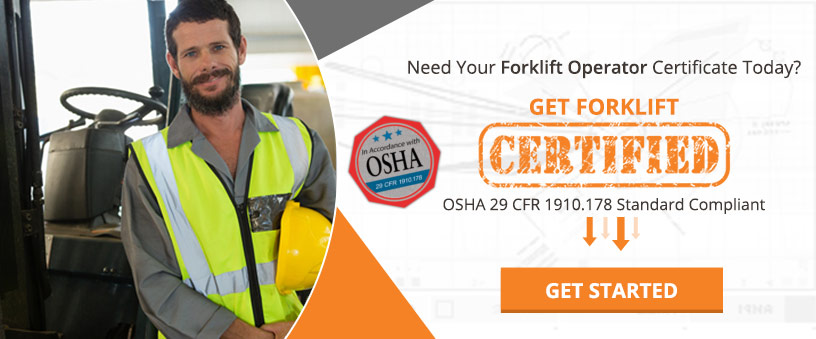OSHA Forklift Certification Training Requirements – Are You Meeting Them?
If you’re searching for OSHA forklift certification requirements, it could be because you’re thinking of becoming a forklift operator. It’s an excellent decision, and you could stand to see a good income from it. The US Bureau of Labor Statistics points out that the median income in the US for material moving machine operators (under which forklift operators fall) is $16.29 per hour or $33,890 per year. Almost 20,000 more jobs are expected to be added to the industry between 2014 and 2024, as well.
In order to get your foot in the door and start enjoying that pay, you need to be certified as a forklift operator, which means you need to meet OSHA forklift certification requirements. What are those requirements, and what is the certification process like?
Understanding OSHA Forklift Certification Requirements
Chances are good that you have a lot of questions about OSHA forklift certification requirements. Before we dive into them, understand that most of the requirements put forth by OSHA apply to employers, as it is their responsibility to ensure that forklift operators are certified. However, you will find forklift training programs available for aspiring operators who want to obtain their certification first before applying for a job.
Each employer (or training program provider) will develop slightly different training programs. This is due to the mandate from OSHA that all training programs be developed to fit the specific requirements of the business and industry in question. However, there are some basics that apply across the board. These include the following:
Operating Instructions – The training course you complete should educate you on the full operation of a forklift, including all controls. This should also include warnings and precautions about operating the forklift in various situations, with different load balances/types, and more.
Instrumentation – You should be familiar with the instrumentation on the forklift you will be using. Note that instrumentation can vary significantly from one forklift model to another, but at least the basic instruments should be understood by the operator (you).
Inspections/Maintenance – As a forklift driver, you need to be able to inspect and maintain a forklift properly. The certification course you complete should teach you the basics of inspecting and maintaining forklifts, as well as other industrial lift trucks.
Limitations – The certification course you complete should explain the concept of operating limitations. These include things like ambient light levels that might make it unsafe to operate a forklift, mechanical situations that might reduce safety, overloading/overbalancing situations, poor maintenance situations, and a great deal more.
Safety – One of the most important focuses of OSHA forklift certification requirements is the safe operation of the forklift. This should include general principles of safety, ranging from avoiding overloading to maintaining the proper speed in operating areas to fork position when in movement, and a great deal more.
Vehicle Types – OSHA’s forklift certification requirements are just one aspect of their wider framework that applies to all types of motorized lift trucks. You’ll find a host of other vehicle types covered, not just conventional forklifts. This can include everything from motorized pallet jacks to telescopic handlers. The training provided should be specific to the type of vehicle you’ll be operating, though – a forklift, in this instance.
Hazards – The use of forklifts is necessary for many workplaces, but it can create a wide range of hazards. OSHA forklift certification requirements include the mandate that any training program describe these hazards in detail and train you on how to avoid them safely. Hazards can range from lifts toppling due to being overloaded with mixed foot traffic and forklift traffic in a particular area. Hazards can also include the impact of exhaust from the forklift engine if using a natural gas, gasoline, or diesel engine rather than a model equipped with an electric motor.
Workplace Specifics – Every workplace varies in terms of hazards, environment, and other considerations. You’ll need to know how to handle things like narrow aisles, pedestrian traffic, load handling in confined quarters, various surface conditions, such as asphalt versus smooth cement, vehicle traffic, and ramps or grades.
Safety Requirements – In addition to the general safety requirements mentioned previously, the OSHA-powered industrial forklift standard includes a broad range of other safety requirements that must be taught in any certification program.
It’s important to realize that your training may vary depending on the field in which you’ll be working. Other potential topics that might need to be included in your training program include refueling/charging, attachment adaptation, engine operation, motor operation, visibility (particularly limited visibility due to loads), and forklift capacity, to name only a few.
There is a great deal of information that must be covered in order to ensure that you’re able to operate a forklift safely and to do so on a regular basis.
Retraining and Refreshers
OSHA’s only requirement in terms of retraining is that you complete all of the forklift certification requirements every three years. You will also need to do so in the case of any refreshers, which are generally given if there has been a safety incident or you were caught by your employer operating the forklift in an unsafe manner.
All of these requirements must be met within a single certification program. Many of these programs are “blended”, meaning that they combine online training with in-person, hands-on training. The challenge here is that it can be extremely time-consuming to complete a blended learning program.
For most aspiring forklift operators, a 100% online forklift certification program is a better option due to the convenience of being able to complete all required OSHA forklift certification requirements in a virtual environment without the need to drive to a testing location or attend a lengthy class in person.





